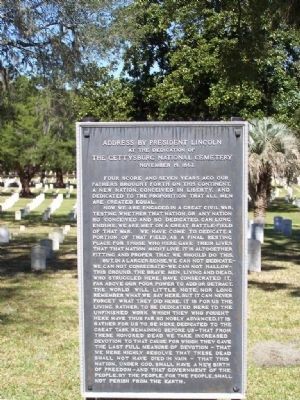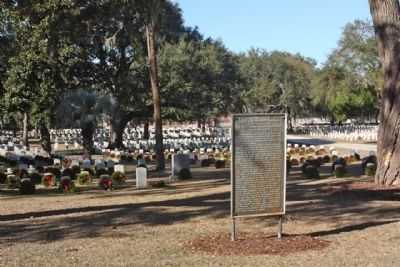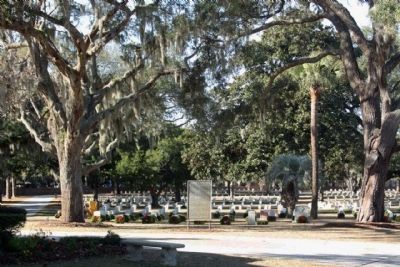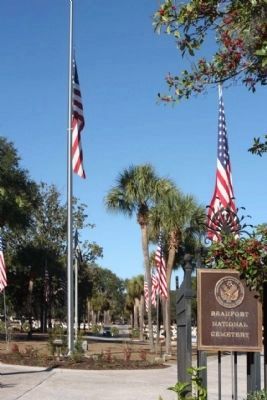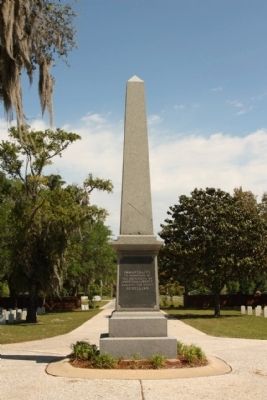Beaufort in Beaufort County, South Carolina — The American South (South Atlantic)
Address by President Lincoln
At the Dedication of The Gettysburg National Cemetery
— November 19, 1863 —
Now we are engaged in a great civil war, testing whether that nation, or any nation so conceived and dedicated, can long endure. We are met on a great battle-field of that war. We have come to dedicate a portion of that field, as a final resting place for those who here gave their lives that that nation might live. It is altogether fitting and proper that we should do this.
But, in a larger sense, we can not dedicate -- we can not consecrate -- we can not hallow -- this ground. The brave men, living and dead, who struggled here, have consecrated it, far above our poor power to add or detract. The world will little note, nor long remember what we say here, but it can never forget what they did here. It is for us the living, rather, to be dedicated here to the unfinished work which they who fought here have thus far so nobly advanced. It is rather for us to be here dedicated to the great task remaining before us -- that from these honored dead we take increased devotion to that cause for which they gave the last full measure of devotion -- that we here highly resolve that these dead shall not have died in vain -- that this nation, under God, shall have a new birth of freedom -- and that government of the people, by the people, for the people, shall not perish from the earth.
Topics and series. This historical marker is listed in this topic list: War, US Civil. In addition, it is included in the Former U.S. Presidents: #16 Abraham Lincoln, and the National Cemeteries series lists. A significant historical date for this entry is November 19, 1863.
Location. 32° 26.415′ N, 80° 40.811′ W. Marker is in Beaufort, South Carolina, in Beaufort County. Marker can be reached from Boundry Street, on the right when traveling west. Located in the Beaufort National Cemetery, shouting distance from the Flag pole, facing northwest. Touch for map. Marker is in this post office area: Beaufort SC 29902, United States of America. Touch for directions.
Other nearby markers. At least 8 other markers are within walking distance of this marker. Beaufort National Cemetery (within shouting distance of this marker); A National Cemetery System (within shouting distance of this marker); 1st SC Infantry Of African Descent (about 400 feet away, measured in a direct line); Re-interred 19 African-American Civil War Volunteers (about 700 feet away); Beaufort (approx. 0.3 miles away); Beaufort Historic District (approx. half a mile away); Grand Army of the Republic Hall (approx. half a mile away); Stephen Elliott Jr (approx. half a mile away). Touch for a list and map of all markers in Beaufort.
Related markers. Click here for a list of markers that are related to this marker. see markers shown.
Also see . . . Beaufort National Cemetery. The original interments in the cemetery were men who died in nearby Union hospitals during the occupation of the area early in the Civil War, mainly in 1861, following the Battle of Port Royal. On May 29, 1989, nineteen Union soldiers of the all black Massachusetts 54th Infantry, whose remains were found on Folly Island, South Carolina in 1987, were buried in the cemetery with full military honors. Members of the cast of the film Glory served as honor guard. (Submitted on December 21, 2012, by Mike Stroud of Bluffton, South Carolina.)
Additional commentary.
1. Beaufort National Cemetery
National Register of Historic Places:
Beaufort National Cemetery (added 1997 - - #97001208)
1601 Boundary St. , Beaufort
♦ Historic Significance: Event
♦ Area of Significance: Military
♦ Period of Significance: 1925-1949, 1900-1924, 1875-1899, 1850-1874, 1825-1849, 1800-1824
♦ Owner: Federal
♦ Historic Function: Funerary
♦ Historic Sub-function: Cemetery
♦ Current Function: Funerary
♦ Current Sub-function: Cemetery
The Beaufort National Cemetery is significant because of its association with the Civil War as well as beyond the Civil War era, as the remains of veterans associated with every war and branch of service are interred here. The national cemetery was established in 1863. The period of significance ends in 1942, the year that Machinist Mate Gerd Reussel, a German World War II prisoner of war, was buried in the cemetery. The site is laid out in the shape of a half wheel. The cemetery’s roads form the spokes, and the large iron gates are set at the hub. The main entrance is at the center of the south side and is protected by a double iron gate, which was constructed in 1940. The cemetery was originally enclosed by a wooden picket fence, which was replaced with a brick wall circa 1876. The original lodge was a wooden cottage with three rooms, which was constructed outside the walls of the cemetery and was moved to inside the cemetery in 1877. In 1881, a lodge of the standard design by Quartermaster General Montgomery C. Meigs, was constructed near the former lodge. The Meigs lodge was used until 1934, when a new two-story brick and frame Dutch Colonial Revival style structure was constructed. The brick and stucco maintenance building, with a galvanized metal roof, was constructed in 1894. Three commemorative monuments or memorials are also located in the cemetery. Listed in the National Register October 10,
1997.(South Carolina Department of Archives and History)
— Submitted December 21, 2012, by Mike Stroud of Bluffton, South Carolina.
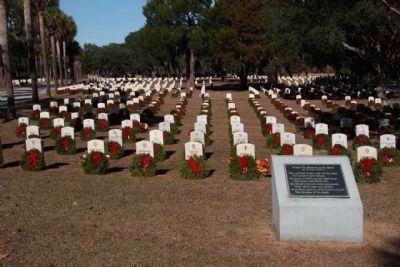
Photographed By Mike Stroud, December 19, 2012
5. Gettysburg Address Marker found near the ever-present poem
By Theodore O'Hara
The muffled drum's sad roll has beat
The soldier's last tattoo;
No more on life's parade shall meet
That brave and fallen few.
On Fame's eternal camping-ground
Their silent tents are spread,
And Glory guards, with solemn round,
The bivouac of the dead.
Credits. This page was last revised on February 19, 2018. It was originally submitted on December 20, 2012, by Mike Stroud of Bluffton, South Carolina. This page has been viewed 827 times since then and 20 times this year. Last updated on February 19, 2018, by Craig Baker of Sylmar, California. Photos: 1, 2, 3, 4, 5, 6. submitted on December 20, 2012, by Mike Stroud of Bluffton, South Carolina. • Bill Pfingsten was the editor who published this page.
